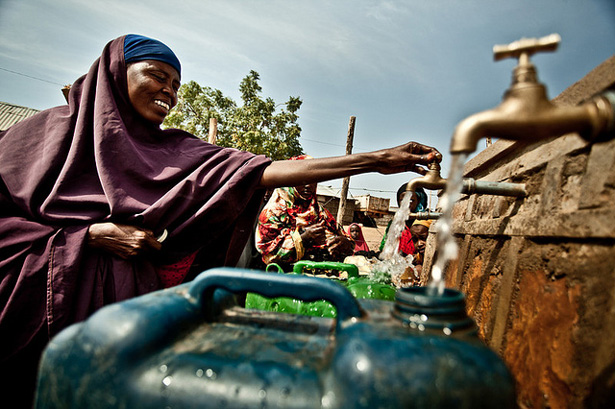-
Should Maternal Health Goals Be Combined With WASH?
January 17, 2013 By Lauren Herzer Risi
Does access to quality water and sanitation have an effect on maternal health outcomes? That was a surprising topic of discussion on day one of the second-ever Global Maternal Health Conference hosted this week in Arusha, Tanzania.
Surprising because, to be honest, I did not think there would be strong disagreements over the relationship between water and sanitation (WASH) and maternal health. In my work with the Comparative Urban Studies Project, the two seem to be clearly linked.
Hosted by the Maternal Health Task Force, the 2013 Global Maternal Health Conference brings together researchers, scientists, policymakers, donors, and practitioners to network, exchange knowledge, and engage in discussions on how to improve the quality of maternal health care around the world. My colleague, Sandeep Bathala, and I will be here all week reporting back on discussions and developments.
Linkages Found in the Field
There are over 100 panel discussions planned for the conference on everything from HIV/AIDS to Malaria during pregnancy. The water and sanitation event I attended was about how WASH efforts might help better enable maternal health goals.
The effect of quality water and sanitation on maternal health is “one of our blind spots around maternal health…it’s an issue that hasn’t featured dominantly,” said Wendy Graham of the University of Aberdeen and the U.K. Department of International Development in her opening of the discussion.
But Oliver Cumming, of the London School of Hygiene and Tropical Medicine, suggested that maternal health and water and sanitation can be linked in many places. In a study, he found that 81 percent of home births in Bangladesh took place in homes that lacked improved water and/or sanitation; 90 percent in India; 98.5 percent in Tanzania; and 97 percent in Malawi. Looking closer, he found that homes deemed “WASH-unsafe” (lacking improved water and/or sanitation) most often lacked improved sanitation versus improved water. For example, of the 90 percent of homes considered WASH unsafe in India, 82.1 percent had water but no sanitation and just 0.8 percent had improved sanitation but lacked access to safe water.
Addressing the two together, via the UN’s Millennium Development Goals framework for example, might therefore make sense.
Millennium Development Goal 5 calls for an improvement of maternal health; MDG 7c calls for improved water and sanitation. The first target of MDG 5 is to “reduce by three quarters, between 1990 and 2015, the maternal mortality ratio.” The United Nations reports that, while progress is being made, the rate of reduction is well below the rate needed for success. And while the world is “on track to reach the drinking water target”, the sanitation target is “out of reach.” Two-and-a-half billion people still lack access to safe sanitation, and even with the water target nearing completion, 780 million people are still without access to safe drinking water.
“When I was first approached to look at the links between water, sanitation, and Millennium Development Goal 5, I thought it was silly,” said Oona Campbell, also of the London School of Hygiene and Tropical Medicine. But, like Cumming, she soon found there was a connection in the field.
In an examination of three studies that looked at sanitation and the association of maternal mortality, Campbell found that women who lived in households with poor sanitation were more than three times more likely to die. The statistical correlation with water was less significant, yet still evident, at 1.5 times more likely to die.
Incentives for Collaboration
Despite the clear challenges to maternal health posed by poor water and sanitation, both Campbell and Cumming added asterisks to their conclusions. Campbell called for more systematic reviews and primary research; Cummings self-deprecatingly remarked that his expertise was in WASH, not maternal health.
A woman in the audience challenged the panelists’ reluctance to advocate their findings. “Why are you being so cautious?” she prodded. An epidemiologist herself, she argued that if she and her colleagues had run a study that had found such statistical significance as those that Campbell found hers, they would have been confident in their findings. Campbell and Cummings attributed their hesitation to some of the initial responses they had received from stakeholders and the fact that their studies were high level and lacked primary research.
Certainly further research is always helpful, but, regardless, the evidence presented during the session made it clear that there could be real value in the WASH and maternal health sectors adjusting their approaches to harness potential synergies.
“At a policy level, there is definitely sufficient data here…to issue that call for policy coherence,” Cumming said. “Specifically, what we’re seeing here is potential incentives for collaboration between the maternal health community and WASH community.”
The Wilson Center’s Sandeep Bathala and Lauren Herzer blogged from the 2013 Global Maternal Health Conference in Arusha, Tanzania, from January 15 to 17, 2013.
Sources: Maternal Health Task Force, UN.
Photo Credit: Water point in Ethiopia, courtesy of Pablo Tasco/Oxfam International.
Topics: development, Dot-Mom, environment, family planning, From GMHC 2013, gender, global health, India, Malawi, maternal health, sanitation, Tanzania, water
 A Publication of the Stimson Center.
A Publication of the Stimson Center.



